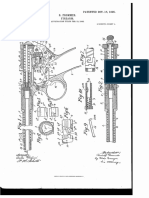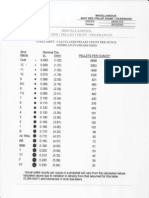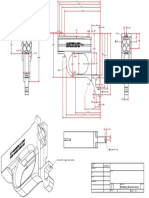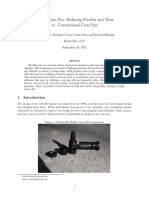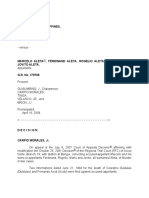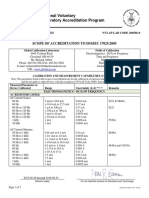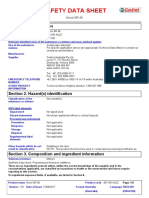Refurbishing A Clansman Battery: Colin Guy G4DDI
Refurbishing A Clansman Battery: Colin Guy G4DDI
Uploaded by
Scott WyattCopyright:
Available Formats
Refurbishing A Clansman Battery: Colin Guy G4DDI
Refurbishing A Clansman Battery: Colin Guy G4DDI
Uploaded by
Scott WyattOriginal Description:
Original Title
Copyright
Available Formats
Share this document
Did you find this document useful?
Is this content inappropriate?
Copyright:
Available Formats
Refurbishing A Clansman Battery: Colin Guy G4DDI
Refurbishing A Clansman Battery: Colin Guy G4DDI
Uploaded by
Scott WyattCopyright:
Available Formats
The VMARS Newsletter Issue 27
Refurbishing a Clansman Battery
Colin Guy G4DDI
New battery packs are available for the Clansman radios, (eg www.milpower.co.uk ) but they are serious money. Used
packs are readily available, but being NiCads, they are likely to have a very limited life and reduced capacity.
The one I obtained also exhibited a strange effect in that it First, make sure the battery is fully discharged then begin by
would charge up and give the correct 24V terminal voltage, carefully drilling out the pop rivets holding the metal top of the
but if left on the shelf the voltage would fall quite suddenly case in place and ease the top away. You will find a thin
after a few minutes to around 20V, and the battery would heat fibreglass insulating layer beneath it, peel this away to reveal
up quite noticeably, suggesting an internal short. the top layer of cells, embedded in that horrible expanding
Measurement of the pack suggested that it’s internal foam material. Carefully pick this away with a small
dimensions were five ‘D’ cells by two ‘D’ cells by two ‘D’ cells: screwdriver around one or two cells in the centre of the pack,
5x2x2=20, each Ni-Cad ‘D’ cell is 1.2 volts: 20x1.2=24, the taking care not to damage the cells unduly. If, as I did, you
required voltage, so I decided to see if was is possible to find evidence that the cells have leaked, take personal
dismantle the battery pack.
Firstly, though, a word on charging NiCad batteries. A very
good description of the internal workings of these batteries is
given at
http://www.wppltd.demon.co.uk/WPP/Batteries/Chemistry/che
mistry.html . Suffice it to say here that they have to be
charged from a constant current source; the normal rate is
1/10 th of the Ah capacity of the cell. The Clansman batteries
vary between about 3 and 5 Ah, depending on the age and
manufacturer of the battery, so for say a 3.5 Ah battery, the
charging rate would be 350mA. At this rate it would take a
theoretical 10 hours to fully charge a flat battery, in practice it
takes 14 hours due to losses. Once the battery is fully
charged, an internal process prevents damage to the battery Fig.1 The top layer of cells removed
should charging continue at this rate. Clearly, however, it is
impractical in many situations to wait for 14 hours to charge a
battery, imagine having to do this from a hand generator for protection precautions as small amounts of Potassium
instance! Hydroxide may have been released, and this is highly
However, it is possible to charge a battery in a much shorter poisonous. Eventually you should be able to loosen the cells
time by using a higher charging current, and this will not harm and extract the top layer one by one, twisting them gently to
the battery whilst it is charging. However, once fully charged break the connections, then do the same for the bottom layer.
the battery cannot store any more energy and the excess is At some point you should come across a pair of thin wires
dissipated as heat, and causes damage to the cell, and inside a piece of plastic sleeving, this is the diode sensor: take
releases hydrogen and oxygen with possible serious great care not to damage this, it will need to be replaced
consequences. Whilst charging at these higher currents, the afterwards. When all the cells are out, clean out the
battery remains substantially at room temperature but once remaining foam from the sides and bottom of the casing.
fully charged a substantial rise in temperature occurs. There is no need to remove the foam from the area beneath
The Clansman chargers appear to operate at about 1.5A the connecting terminals: there is another sensing diode
charging current, and will therefore charge a 3.5 Ah battery in embedded in this area which could easily be damaged. You
about 2½ hours. To prevent damage to the battery by should be left with a red and a black wire, as well as the
overcharging a method of detecting the temperature rise is sensor described above, which disappear into the remaining
needed. In the Clansman battery are two temperature foam around the connectors, these are of course the positive
sensors, which are in fact silicon diodes. One is embedded
amongst the cells in the pack, and one is mounted close to
the metal casing. The latter detects the ambient temperature
and when the embedded diode senses a higher temperature
the charger is signalled that the battery is fully charged and
the lamps on the charger change from ‘proceeding’ to
‘complete’. Fig 5 shows the wiring of the charger connector
on the battery pack.
Rebuilding the Battery.
As stated above, the Clansman 24 volt battery requires 20 ‘D’
cells. These vary in price, but you do get what you pay for to Fig.2 The new cells connected up
some extent. They are also available in various capacities.
The best compromise I found was to buy 2.4 volt batteries and negative connections to the cell stack. There should also
intended for emergency lighting units. These 4.5Ah units be another insulating layer on the bottom of the case, check
consist of two ‘D’ cells in-line, in a shrink-wrap, and cost £6.88 the condition of this and if it is at all damaged, it should be
each from CPC at Preston (www.cpc.co.uk ) It is possible that removed.
they may be cheaper from other sources of course. You will Lay five of the new cell stacks side by side and solder the
require 10 of these, so the cost is approaching £70, but I think tags together positive to negative (or if you are using
it worthwhile if you are seriously keen on going out /p! If you individual cells you will have to make them up into inline pairs
really want to push the boat out, a 7Ah ‘D’ cell is available for first). Tape them together then lay the other five on top and
£8.17 per cell! connect up in a similar manner. It is a good idea to place a
6 February 2003
The VMARS Newsletter Issue 27
volts unless the cells are totally flat. If it is any less,
check for reversed cells, it is easy to do if you are not
careful. When you are satisfied that the wiring of the
cells is correct, place a piece of insulating material in
the bottom of the battery case and ease the new cell
pack into the case. Then slide a suitably sized piece
of insulating material between the cells and the case
on each side and on top. Relocate the sensor diode
in the centre of the cell pack, and connect the red
and black wires to the appropriate terminals of the
cells. Refit the top metal cover but do not re-rivet it at
Fig 3. Test charging this stage, a couple of self - tapping screws will
locate it if it is loose.
Now is the time to charge the battery: give it a couple of
piece of thin insulating material between the two layers, I use hours, if the indicator lamp on the charger doesn’t change
the clear plastic sheeting in which many things are packaged over see if the cells are any more than just warm, if not give
these days, but probably better would be thin fibreglass sheet them a little longer, if they are quite hot you may have
damaged one of the diodes; they can be checked for
continuity with a multimeter, (see fig 5). If all is well clip the
pack to your radio and see how long it works for! It may be
necessary to charge and discharge new cells a few times
before full capacity is achieved.
When you are quite
sure the battery is
working properly,
remove the cover and
add some more
insulation as
necessary to make
sure the cells aren’t
loose. You can buy
Fig.5 Charging socket connections
small cans of
Fig.4 Final testing before the lid goes back on! expanding foam from diy stores and builders merchants, but I
would suggest not using this material unless you really want
to make the pack ‘squaddieproof’, as sooner or later the cells
as in the original battery if you can get it (it is more heat
will fail again!! Also, the foam is expensive and once a can is
resistant). The original battery relied only on the ‘heatshrink’
started, it ‘goes off’ very quickly and so is wasted, it’s only an
wrap of the cells for inter-cell insulation, as you can see in
economical proposition if you are doing several batteries
fig.1 this has not fared too well!
together. Either way, replace the cover, ‘pop’ in some new
When the cells are all connected up it is a good idea to
rivets and no-one will know its been apart.
measure the terminal voltage – it should be very close to 24
7 February 2003
You might also like
- BdnarrivalDocument24 pagesBdnarrivalgavilan071No ratings yet
- Practical Scrap Metal Small Arms Vol. 21 - Stingray Machine PistolDocument30 pagesPractical Scrap Metal Small Arms Vol. 21 - Stingray Machine PistolScott Wyatt89% (162)
- Us Special Forces Antenna ManualDocument174 pagesUs Special Forces Antenna ManualScott Wyatt67% (3)
- 4 Star Spangled Girl WKDocument7 pages4 Star Spangled Girl WKAnonymous PYPVSwR100% (2)
- Anzio Sniper Rifle WIKIDocument3 pagesAnzio Sniper Rifle WIKIKhairulnizam BakeriNo ratings yet
- HK 630 770 and 940 ManualDocument12 pagesHK 630 770 and 940 Manualjustin_j_gaudetNo ratings yet
- AMP Engineering PS90 Trigger InstructionsDocument2 pagesAMP Engineering PS90 Trigger InstructionsAaron PigeonNo ratings yet
- DIWire Bender BOMDocument2 pagesDIWire Bender BOMramjoceNo ratings yet
- Primers For Small Arms Cartridges - Albert and OelbergDocument47 pagesPrimers For Small Arms Cartridges - Albert and OelbergScott Wyatt100% (5)
- Primers For Small Arms Cartridges - Albert and OelbergDocument47 pagesPrimers For Small Arms Cartridges - Albert and OelbergScott Wyatt100% (5)
- Desi Katta Construction GuideDocument13 pagesDesi Katta Construction GuidePPK3271% (7)
- Peoria County Inmates 11/18/12Document9 pagesPeoria County Inmates 11/18/12Journal Star police documents0% (1)
- Design of Fluid Systems-Hook-UpsDocument161 pagesDesign of Fluid Systems-Hook-UpsMohammed Hassan B KorainaNo ratings yet
- Single Layer Winding of Three Phase Induction Motor: Enesi Asizehi YahayaDocument6 pagesSingle Layer Winding of Three Phase Induction Motor: Enesi Asizehi YahayaHuong Thao Le LuongNo ratings yet
- MOD 125 SniperDocument3 pagesMOD 125 SniperCarlos EduardoNo ratings yet
- Bauska Brill Korean Magnum MauserDocument2 pagesBauska Brill Korean Magnum MauserIM_JohnnyVNo ratings yet
- HK USC45 ManualDocument23 pagesHK USC45 Manualjustin_j_gaudet100% (1)
- Spectre 3x ManualDocument2 pagesSpectre 3x Manualakms1982100% (1)
- Manual SupplementDocument4 pagesManual SupplementxnsxmannyNo ratings yet
- Realistic TRC 422a OmDocument20 pagesRealistic TRC 422a OmAntonio GomezNo ratings yet
- Remington Defense MODEL 700PDocument1 pageRemington Defense MODEL 700PtedDRAKENo ratings yet
- Upload A Document - ScribdDocument3 pagesUpload A Document - Scribdsimon tutelianNo ratings yet
- CFD Simulation: Ansys Fluent 13.0Document34 pagesCFD Simulation: Ansys Fluent 13.0Shaffri SabriNo ratings yet
- M 762Document110 pagesM 762Hossam AliNo ratings yet
- Beretta 2011 USAExport CatalogDocument34 pagesBeretta 2011 USAExport Catalogrcatalin_20No ratings yet
- Lock N Load AP Press InstructionsDocument36 pagesLock N Load AP Press InstructionsthomasmpbetressNo ratings yet
- Gepard M6 .50BMG RifleDocument9 pagesGepard M6 .50BMG RifleGautam Natrajan100% (1)
- Cheytac Long Range Rifle SystemDocument25 pagesCheytac Long Range Rifle SystemGcmarshall82No ratings yet
- Reloading Bulged Pistol Brass-Rev2Document10 pagesReloading Bulged Pistol Brass-Rev2Brian RobinsonNo ratings yet
- 5 Olympic - Whitney - Wolverine PDFDocument16 pages5 Olympic - Whitney - Wolverine PDFrico oliverNo ratings yet
- Leader USAR Sentry enDocument1 pageLeader USAR Sentry enForum PompieriiNo ratings yet
- The 5.56 X 45mm - 1968 - 1969 - A Chronology of Development (Part 6) - by Daniel WattersDocument38 pagesThe 5.56 X 45mm - 1968 - 1969 - A Chronology of Development (Part 6) - by Daniel Wattersblowmeasshole1911No ratings yet
- Barrett M95Document2 pagesBarrett M95Ishrat Hussain TuriNo ratings yet
- DSP KevlarXP ReferenceDesigns K23338Document1 pageDSP KevlarXP ReferenceDesigns K23338agus2202No ratings yet
- Tavor TAR-21 Assault Rifle - IsraelDocument4 pagesTavor TAR-21 Assault Rifle - IsraelRichard HarigNo ratings yet
- 1970 US Army Vietnam War Vietnam - M60 Machine Gun Manual 32pDocument32 pages1970 US Army Vietnam War Vietnam - M60 Machine Gun Manual 32pwwwsurvivalebookscomNo ratings yet
- DPMS Barrels 050-066Document17 pagesDPMS Barrels 050-066thecopterguyNo ratings yet
- Us Ngic Iraq Small Arms 2004 - WikileaksDocument13 pagesUs Ngic Iraq Small Arms 2004 - WikileaksmclmmNo ratings yet
- ENG Rws Centerfire-Rifle-Cartridges Brochure 1Document41 pagesENG Rws Centerfire-Rifle-Cartridges Brochure 1vihkr9506No ratings yet
- Frommer PistolDocument10 pagesFrommer Pistolcll1968No ratings yet
- How To Adjust HK Rifle SightsDocument3 pagesHow To Adjust HK Rifle SightsBlackbenellieSBE1No ratings yet
- Miscellaneo - .,S: Shgi Stze / Pellet Count R Tolerances Ob/03/200Document1 pageMiscellaneo - .,S: Shgi Stze / Pellet Count R Tolerances Ob/03/200angelines123No ratings yet
- For The Toughest Hunts and The Toughest Hunters, It's Just A Better GunDocument15 pagesFor The Toughest Hunts and The Toughest Hunters, It's Just A Better GunJeremi LeeNo ratings yet
- Buying First RifleDocument5 pagesBuying First RiflesgrispoNo ratings yet
- Crimsontrace Ar15-M16 Manual LAZER SIGHTDocument9 pagesCrimsontrace Ar15-M16 Manual LAZER SIGHTDennis KlinemanNo ratings yet
- Testing of An Im Upgraded M430A1 40 MM GrenadeDocument13 pagesTesting of An Im Upgraded M430A1 40 MM GrenadeNORDBNo ratings yet
- FM 2327 MK 19 4Mm Grenade Machine Gun MOD 3Document236 pagesFM 2327 MK 19 4Mm Grenade Machine Gun MOD 3Jhon PrietoNo ratings yet
- Manual para Ordnance 1911Document29 pagesManual para Ordnance 1911john_oscNo ratings yet
- Accuracy International Arctic WarfareDocument17 pagesAccuracy International Arctic WarfareJohn ShitNo ratings yet
- Firing Pin Impact StudiesDocument3 pagesFiring Pin Impact Studiesblowmeasshole1911No ratings yet
- Owners Manual: Handling & Safety Instructions: When It CountsDocument104 pagesOwners Manual: Handling & Safety Instructions: When It CountsJorge MontillaNo ratings yet
- HK243 S Sar - HK243 S Tar WS en 001.0817Document1 pageHK243 S Sar - HK243 S Tar WS en 001.0817LIVE3ORDIENo ratings yet
- Mossberg Brownie Barrel PDFDocument1 pageMossberg Brownie Barrel PDFCarlos sandoval100% (2)
- Truvelo SR Brochure 2011Document12 pagesTruvelo SR Brochure 2011Dark God100% (1)
- Sturmgewehr 44 Assault RifleDocument8 pagesSturmgewehr 44 Assault RifleTimia TalashekNo ratings yet
- m14 Maintenance 3Document4 pagesm14 Maintenance 3entomophileNo ratings yet
- John Niles Et Al - Mitigating Shaped Charge Jet ImpactDocument20 pagesJohn Niles Et Al - Mitigating Shaped Charge Jet ImpactMermaczNo ratings yet
- AR15 Roller Cam Pin - Reducing Friction and Wear vs. Conventional Cam Pins HydraFireAR15RollerCamPinFrictionStudyDocument10 pagesAR15 Roller Cam Pin - Reducing Friction and Wear vs. Conventional Cam Pins HydraFireAR15RollerCamPinFrictionStudyRob ZelNo ratings yet
- .22 CB Cartridge DetailsDocument2 pages.22 CB Cartridge Detailsblowmeasshole1911No ratings yet
- PREPARE Policy BriefingDocument2 pagesPREPARE Policy BriefingAndrew SingerNo ratings yet
- MS - The SIG-Sauer 3000 Sniper RifleDocument14 pagesMS - The SIG-Sauer 3000 Sniper Riflemrek68No ratings yet
- General-Purpose Machine Gun - WikipediaDocument4 pagesGeneral-Purpose Machine Gun - WikipediasorinartistuNo ratings yet
- Awc CatalogDocument23 pagesAwc CatalognachosuaveNo ratings yet
- EOLAD User ManualDocument80 pagesEOLAD User ManualRazza WilliNo ratings yet
- The Development of Armor-piercing Shells (With Suggestions for Their Improvement)From EverandThe Development of Armor-piercing Shells (With Suggestions for Their Improvement)No ratings yet
- Punching Holes: Buying Ammunition, Gun Accessories, Knives and Tactical Gear at Wholesale PricesFrom EverandPunching Holes: Buying Ammunition, Gun Accessories, Knives and Tactical Gear at Wholesale PricesNo ratings yet
- Functional Composite Materials: Manufacturing Technology and Experimental ApplicationFrom EverandFunctional Composite Materials: Manufacturing Technology and Experimental ApplicationNo ratings yet
- 75 Round Magazine InstructionsDocument2 pages75 Round Magazine InstructionsScott WyattNo ratings yet
- USArmy SpecialForcesFreeFallOpsDocument398 pagesUSArmy SpecialForcesFreeFallOpsScott Wyatt100% (1)
- DHS HomemadeExplosivesGuideDocument80 pagesDHS HomemadeExplosivesGuideScott Wyatt100% (3)
- Phosphorus Smoke CompositionsDocument1 pagePhosphorus Smoke CompositionsScott Wyatt100% (1)
- Solarman Weather Station User Manual 2019Document21 pagesSolarman Weather Station User Manual 2019Trần Thanh HòaNo ratings yet
- ADWEA Vendor List As On 26th July 2010Document234 pagesADWEA Vendor List As On 26th July 2010mimran18No ratings yet
- RosuvastatinDocument2 pagesRosuvastatinShaira Richelle OmagapNo ratings yet
- Burger Boy Sporty GirlDocument64 pagesBurger Boy Sporty GirlRoshni MahapatraNo ratings yet
- Electrical Safety in Power Gen., Trans., & Distribution.Document18 pagesElectrical Safety in Power Gen., Trans., & Distribution.MY PCNo ratings yet
- Emily Peralta-Sosa - Capstone Paper Rough DraftDocument4 pagesEmily Peralta-Sosa - Capstone Paper Rough Draftapi-606449019No ratings yet
- Nirmiti ProfileDocument18 pagesNirmiti ProfilePRAVIN GUNJALNo ratings yet
- AIRCONDocument7 pagesAIRCONDECIPOLO, KENNETH JOHN E.No ratings yet
- Argumentative Essay Edited VersionDocument2 pagesArgumentative Essay Edited Versionemi dilizNo ratings yet
- Dimensions & Weights of Pipes ASTM A53Document4 pagesDimensions & Weights of Pipes ASTM A53MaysaraNo ratings yet
- M-09-05 Actuarial Mathematics ExamDocument223 pagesM-09-05 Actuarial Mathematics ExamStelios VafeasNo ratings yet
- Ticket 4 60457669 27455912Document2 pagesTicket 4 60457669 27455912narayanaNo ratings yet
- Byk Le-G 1 enDocument11 pagesByk Le-G 1 enHelene Di marcantonioNo ratings yet
- Second Division People of The PhilippinesDocument187 pagesSecond Division People of The PhilippinesLuigi JaroNo ratings yet
- Bread and Pastry ProductionDocument17 pagesBread and Pastry ProductionJerwin LualhatiNo ratings yet
- Computers in Human Behavior: Karina Caro, Ana I. Martinez-Garcia, Mónica Tentori, Ivan Zavala-IbarraDocument19 pagesComputers in Human Behavior: Karina Caro, Ana I. Martinez-Garcia, Mónica Tentori, Ivan Zavala-IbarraarthurqazwerNo ratings yet
- NVLAP Scope - Certificate - 2015 09 28Document7 pagesNVLAP Scope - Certificate - 2015 09 28Alex SambagiNo ratings yet
- Biomultis Ep 2 TDS v211125Document2 pagesBiomultis Ep 2 TDS v211125JayantNo ratings yet
- Audits of Emergency Trolleys Contents in SelectedDocument7 pagesAudits of Emergency Trolleys Contents in SelectedStephanieNo ratings yet
- MSDS For Aircol SR 46 PDFDocument8 pagesMSDS For Aircol SR 46 PDFCycyblNo ratings yet
- Perinatal InfectionsDocument24 pagesPerinatal InfectionsAlexandra OanaNo ratings yet
- Self Compacting Concrete Using Bagasse AshDocument17 pagesSelf Compacting Concrete Using Bagasse AshSumit Sulibhavi 2BA18CV434No ratings yet
- Return Policy Benchmarks Report - Aug 2021Document29 pagesReturn Policy Benchmarks Report - Aug 2021Thao LeNo ratings yet
- ANC AssignmentDocument6 pagesANC AssignmentKaustav DuttaNo ratings yet
- HPEX 354 - Power Points For Chapter 1Document51 pagesHPEX 354 - Power Points For Chapter 1Michelle ValenzuelaNo ratings yet
- Swadhyay ManobodhDocument220 pagesSwadhyay ManobodhjaylinuxNo ratings yet
- Research 2.0Document22 pagesResearch 2.0Seila MolinaNo ratings yet






































